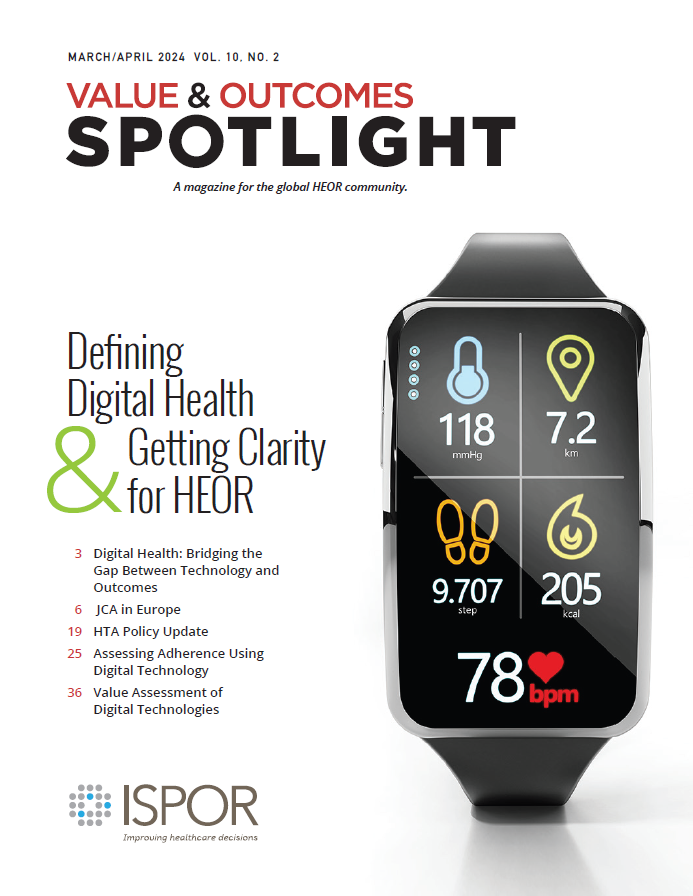The Digital Transformation of Health
Rob Abbott, ISPOR CEO & Executive Director
 It’s no exaggeration to suggest that the healthcare industry is in a state of disruption. Its business infrastructure is being leapfrogged as society moves toward digital channels for information, transactions, and interactions. In the wake of the COVID-19 pandemic, patients have more agency and self-determination and expect high-quality care that is accessible, effective, efficient, and affordable. These expectations are driving healthcare systems to confront digital technologies that will transform current care models, business processes, and patient and member experiences.
It’s no exaggeration to suggest that the healthcare industry is in a state of disruption. Its business infrastructure is being leapfrogged as society moves toward digital channels for information, transactions, and interactions. In the wake of the COVID-19 pandemic, patients have more agency and self-determination and expect high-quality care that is accessible, effective, efficient, and affordable. These expectations are driving healthcare systems to confront digital technologies that will transform current care models, business processes, and patient and member experiences.
It is in this context that I welcome this issue of Value and Outcomes Spotlight that is dedicated to exploring the digital transformation of health. It is appropriate to define “digital transformation” for our purposes here. It is the practice of using technology to add value to patients and healthcare organizations in a way that, at least in theory, maximizes benefits for both. Popular examples include the seemingly ubiquitous “wearable technologies” (Fitbit, anyone?) and the development of the infrastructure needed to support telehealth and other remote, virtual healthcare solutions.
Technological innovation has become an integral part of our lives. Whether booking a hotel or airfare, watching a movie, or buying something for the house, we increasingly use devices of various types to get things done. It’s sometimes hard to believe that companies like Amazon, Apple, and Alphabet (parent company of Google), which dominate the Fortune 500, are all very young – Google’s IPO, for instance, was in 2004. In a healthcare context, wearable technologies that track a variety of health metrics, the onset and rapid acceleration of telehealth, and the creation of “patient portals” that provide useful information for both the patient and the doctor are all expressions of the digital transformation of healthcare.
And there is so much more to come.
By 2025, according to research by Global Market Insights, the world’s digital healthcare market is expected to be worth more than $500 billion annually. If nothing else, this is a strong signal of the potentially transformative impact technology can bring to healthcare. Meantime, research by Deloitte Insights shows that patients are increasingly exercising greater agency, engagement, and control over most decisions about their health and well-being[i].
To be sure, there is considerable opportunity to transform healthcare through technologies already in the market, and many others that are in various stages of deployment. The use of artificial intelligence to automate record keeping or refine predictive diagnostics and the creation of patient treatment plans is a topical example that is discussed in this themed issue of Value & Outcomes Spotlight. So too, the development and deployment of medical robots to perform complex surgeries. As noted in a recent paper by Sakshi Bramhe and Swanand Pathak[ii], robotic surgery “is commonly done in the surgical community to an incredible level.” The use of 3D printing to create prosthetics, big data to create patient profile and/or treatment plans, and cloud computing to help deliver remote healthcare are other examples of the digital transformation of healthcare.
The putative benefits of digital solutions are many—for both providers and patients—and include:
Provider Benefits:
- reduced time for patient examination
- more effective remote communication between doctors and patients
- more efficient communication between medical staff
- creation of a secure database for electronic medical records
Patient Benefits:
- access to personalized healthcare services
- real-time tracking of health metrics
- access to personal health records
- more convenient appointment scheduling
Lest we view the digital transformation of healthcare with the proverbial rose-colored glasses, it is important to note some of the challenges that might otherwise get in the way of wide adoption of new technologies. These include data privacy and security; the historic inertia that makes healthcare organizations resistant to change; interoperability issues that make it difficult, if not impossible, to marry legacy systems with new digital applications; and the challenges of bringing new IT skills and talents to doctors and other healthcare providers. Some of these challenges are also discussed in this issue of Value & Outcomes Spotlight.
At ISPOR, we increasingly strive to leverage our experience and expertise in health economics and outcomes research to help forge a world in which healthcare is accessible, effective, efficient, and affordable for all. A critical part of this is rigorously examining the value of new technologies. With this in mind, the articles in this issue of Value & Outcomes Spotlight serve as both a sign of things to come, and equally, a signal of our intent to continue “bringing the horizon into the room” and commenting on the efficacy of new ideas and technologies.

